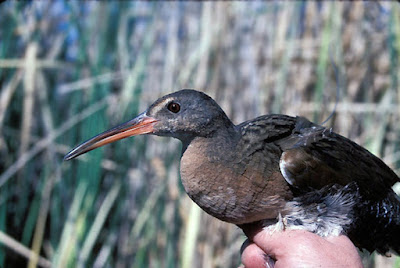 |
| The endangered Yuma Clapper Rail can be spot nesting in the freshwater pond area encircled by the Michael Hardenberger Trail. USFWS photo |
 |
| Michael Hardenberger Trail map. Click for larger version. |
The 0.77-miles Michael Hardenberger Trail is one of only two paths in the wildlife refuge (the other being the Rock Hill Trail). Sitting at the southern tip of the Salton Sea, the refuge was named for the former music and television star who served as Palm Springs’ mayor and local congressman.
It’s a bit of a drive, even for those who live on the Coachella Valley’s southeast side. To reach the trail, take Calif. Hwy. 111 south to Mecca. Once there, turn right/west onto 66th Avenue then left/south onto Calif. Hwy. 86. Take the highway the entire length of the Salton Sea’s southern shore and exit left/east W. Bannister Road (if you’ve gone to Westmoreland, you’ve gone too far). You’re driving through some of the lush farm fields of Imperial County. Take the very next left/north onto the unpaved Vendel Road. The road ends shortly after entering the marsh. Park there.
An observation platform sits at the road’s end. This is a perfect spot to watch birds soaring over the shoreline alkali flats and to see the Salton Sea beyond.
The refuge protects 2200 acres of the Salton Sea, shoreline alkali flats, and freshwater wetlands, all of which are a vital stop along the Pacific Flyway. More than 400 bird species have been seen at the refuge with more than 90 of them nesting there. Some 30,000 geese and other migratory birds winter here. Among the other interesting birds you may spot are the American avocet, black-necked stilt, least bittern, and white-faced ibis.
Yuma clapper rail
For the trail, from the observation platform walk the road south about 300 feet. The trailhead is on the right/west side. When the trail splits, go right/west. The trail forms a rectangle around a small freshwater pond.
The pond is a favorite nesting spot for the endangered Yuma clapper rail. Though weighing a mere 10 ounces, the clapper rail can grow up to 14.5 inches long and sport a 19-inch wingspan. Its dorsal feathers have a grayish edging, and its cheeks can appear blue- or ash-gray.
Right now, most clapper rails are nesting. Their cup nest of grasses and sedges usually contains 7-11 eggs and are laid in March. After hatching, the young can take flight in a mere 9-10 weeks.
In addition to providing material to build nests, the freshwater pond and surrounding marshes provide plenty of food. The clapper rail dines on crayfish, clams, insects, isopods, fish and freshwater shrimp. Its long beak is perfect for probing mud and sand to dig up a meal.
Sun and heat
On the trail’s south side, you can take a spur about 0.1 miles northeast into the pond to a photography blind. This is a great spot catching photos of the clapper rail and other birds.
Upon coming back to the main trail, go left/east, circle back to the trail’s northeast corner, and return to the road.
The trail is entirely open to the sun, so be sure to don sunscreen, sunglasses and sunhat. The lower elevation Salton Sea will be extremely hot in summer, so limit your hikes here to October through April.
